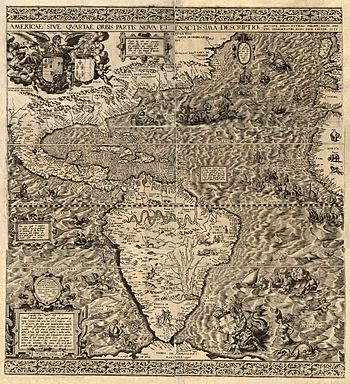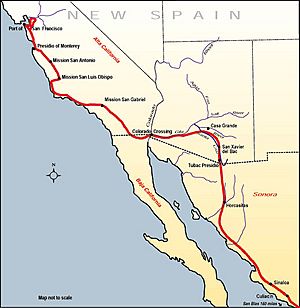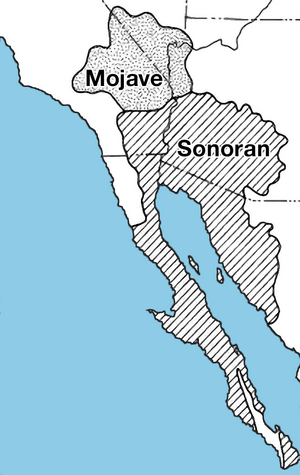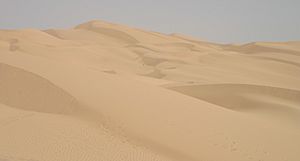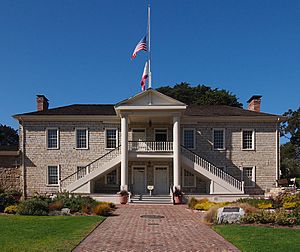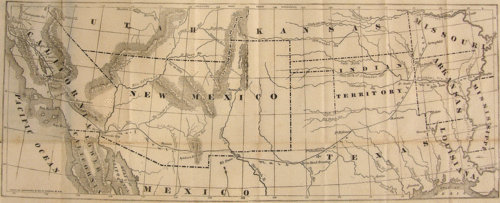History of California facts for kids
The history of California is a long and exciting story! It started with Native Americans living on the land for thousands of years. Then, European explorers arrived, followed by Spanish settlers who built missions and forts. After that, California was part of Mexico for a while. Finally, it became a state in the United States, which it still is today.
California was home to many different Native American tribes. They had rich cultures and spoke many languages. Sadly, after Europeans arrived, many Native Americans died from new diseases.
In 1769, Spanish missionaries began building 21 missions along the coast of Upper California. They also built forts called presidios and small towns called pueblos. Two of these towns grew into the big cities of Los Angeles and San Jose.
In 1821, Mexico won its independence from Spain. California then became part of Mexico. The Mexican government closed the missions and took their land. This left a small group of Spanish-speaking people called "Californios".
After the Mexican–American War (1846-1848), Mexico gave California to the United States. In 1849, gold was discovered! This led to a huge Gold Rush, bringing hundreds of thousands of people from all over the world. Most didn't get rich, but many stayed and helped California grow, especially in farming. California became the 31st US state in 1850.
Contents
Early California: Native Americans and Explorers
Native American Life in California
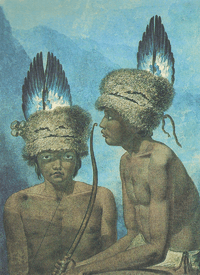
Native American tribes lived in the area now known as California for about 13,000 to 15,000 years. More than 100 different tribes and groups lived here. California had about one-third of all Native Americans in what is now the United States.
These native people were hunter-gatherers. They used special ways of farming, like forest gardening and fire-stick farming. This helped them make sure they had enough food and medicine plants. They controlled fires to keep the forests healthy and prevent big wildfires. This was a kind of "wild" farming that helped them live well.
How California Got Its Name
The name California comes from a popular Spanish adventure novel from the early 1500s. The book described a mythical island called California, where beautiful Amazon warriors lived and used gold tools.
When Spanish explorers first saw the Baja California peninsula, they thought it was an island. So, they named it California. Mapmakers then started using this name for the whole unexplored west coast of North America.
First European Explorers Arrive
European explorers from Spain and England began exploring California's Pacific Coast in the mid-1500s. They hoped to find rich cities or a shortcut to Asia.
The first European to explore the California coast was Juan Rodríguez Cabrillo in 1542, working for Spain. He didn't find any gold or advanced civilizations. So, Spain wasn't very interested in California for a long time.
Cabrillo's group described the Native Americans living in small groups. They didn't seem to farm, and their tools were simple. Their homes were made of branches and mud. Even so, California had a lot of natural resources. Native Americans managed the land well. This allowed many people to live there without farming. They ate deer, elk, fish, seeds, berries, and acorns. Acorns were a very important food. They were dried, ground into flour, and cooked into a mush.
The Native Americans were quite isolated from other tribes in North America. This was because of the high Sierra Nevada mountains, deserts, and the Pacific Ocean. Because there was no easy wealth to find, California remained mostly untouched by Europeans for over 200 years.
Spanish Trading Route and English Claims
In 1565, Spain set up a trade route across the Pacific Ocean. Large ships called Manila galleons carried gold and silver from Mexico to the Philippines. On their way back, they sailed near the California coast. But they didn't explore it much.
In 1579, the English explorer Francis Drake sailed along the northern California coast. He claimed the land for England and called it "Nova Albion". The exact spot where he landed is still a mystery.
In 1602, Sebastián Vizcaíno explored California's coast for Spain. He named San Diego Bay and described Monterey Bay as a good place for ships. His maps were used for almost 200 years.
Spanish Rule in California (1769–1821)
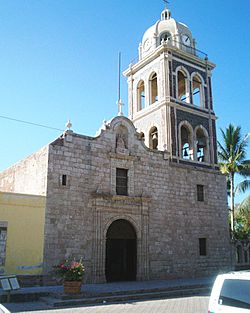
Spain divided California into two parts: Baja California (Lower California) and Alta California (Upper California). Alta California included what is now the state of California.
The first permanent mission in Baja California was founded in 1697. Later, after 1769, Alta California missions were built. Both areas were ruled together from Monterey, California.
Spanish leaders worried that other countries, like Britain and Russia, might try to claim California. So, they decided to settle Alta California. They wanted to do this with as little cost as possible.
The Portolá Expedition (1769–1770)
In 1769, Spain sent a big expedition to settle Alta California. It was led by Gaspar de Portolá and Father Junípero Serra. They traveled by both land and sea. Their goal was to meet in San Diego.
The journey was very hard. Many people got sick, especially from scurvy, and some died. The land groups had to cross about 300 miles of dry, tough land.
The first group arrived in San Diego in May 1769. They set up the Presidio of San Diego (a fort) and Mission San Diego de Alcala. These were the first Spanish settlements in Alta California.
In July 1769, Portolá's group left San Diego to find Monterey Bay. They missed it and instead discovered the huge San Francisco Bay in November 1769. This was a very important discovery! They returned to San Diego, and then established the Presidio and Mission of Monterey in June 1770.
Challenges and Survival
The early settlers faced severe food shortages. They ate their cattle and traded with Native Americans. Many continued to suffer from scurvy. Portolá almost gave up and left California in March 1770. But then, a supply ship arrived just in time! This allowed the Spanish settlement of California to continue.
Anza's Land Routes (1774–1776)
Juan Bautista de Anza led expeditions in 1774 and 1775-1776 to find a land route from Mexico to California. He crossed the Sonoran Desert and the Colorado River. He found friendly Native American tribes who were farming with irrigation.
Anza's second trip brought 240 friars, soldiers, and families to California. They also brought many horses and cattle. These animals started the cattle and horse industry in California. They multiplied quickly because there were few enemies and plenty of grass.
In 1776, Anza's group reached San Francisco Bay. They established the Presidio of San Francisco and Mission San Francisco de Asís (Mission Dolores). This led to the future city of San Francisco.
Later, Native Americans at the Colorado River closed Anza's land route. This made California isolated again. Most people had to travel by sea, which was a long journey.
The California Mission System
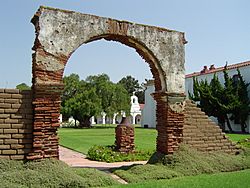
Eventually, 21 missions were built along the California coast, from San Diego to San Francisco. They were about a day's horseback ride apart and connected by the El Camino Real trail.
Each mission had a few friars and soldiers. Most of the work was done by Native Americans. They were taught how to build, farm, speak Spanish, and learn about the Catholic faith. If Native Americans tried to leave the missions, soldiers would bring them back.
The missions controlled a lot of land. The rest of the land belonged to the Spanish king. Large pieces of land were given to retired soldiers and settlers. These became huge farms called Ranchos. The owners of these ranchos lived a grand life. Their workers were mostly Native Americans or poor laborers who were paid with food and housing, but no salary.
The main products of the ranchos were cattle, horses, and sheep. Cattle were killed for meat, hides (skins), and tallow (fat for candles and soap). Hides and tallow were traded for other goods.
Spain also built four forts called presidios in San Diego, San Francisco, and Santa Barbara. Small towns called pueblos were also established to support the missions and forts. These were the only towns in California at the time.
Mexican Rule in California (1822–1846)
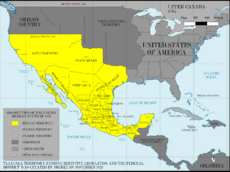
In 1821, Mexico became independent from Spain. Alta California became a territory of Mexico. The capital remained in Monterey.
Mexico was often unstable, with many changes in government. California was a large, empty, and poor area that didn't send much money to Mexico. Also, the number of Native Americans at the missions kept going down.
The number of non-Native American settlers in California slowly grew. Most new people came by ship because the land route from Mexico was closed. California remained a quiet and isolated place.
Trade and Land Changes
Before Mexico took over, Spain had strict rules against trading with foreign ships. But these rules were hard to enforce. Settlers, known as Californios, wanted to trade for new goods. Mexico changed the rules, and soon many foreign trading ships came to California.
Ships traded cattle hides and tallow for finished goods. The book Two Years Before the Mast describes this trade. From 1825 to 1848, about 25 ships came to California each year.
The main port for trade was Monterey. High taxes were charged on goods, which helped pay for the California government. But these high taxes also led to a lot of smuggling.
The Missions Under Mexico
Many Native Americans at the missions died from diseases and harsh conditions. The number of births was much lower than the number of deaths. The missions were supposed to last only about ten years, but some had been around for over 60 years. The Native Americans were still not fully independent or Catholic.
In 1834, Mexico decided to close the missions. The mission lands and cattle were supposed to go to the Native Americans. But in reality, most of the land and animals were taken by about 455 large ranchos. These ranchos were given to friends and families of the governors, often for free.
The rancho owners claimed huge amounts of land. They tried to live like rich landowners in Spain. This was a "Golden Age" for the few rancho families, but not for most people. Many of the farms and orchards started by the missions were abandoned. The ranchos mostly grew enough food for themselves and to trade with ships.
The main products were cattle hides and tallow. These were traded with ships from Boston, which sailed all the way around Cape Horn. The cattle and horses grew wild.
By 1845, California had about 8,000 non-Native American people. Most of them were Californios living in the southern part of the state.
A large land grant was given to John Sutter in 1839. He built Sutter's Fort near what is now Sacramento, California. This was the first non-Native American settlement in the Central Valley. Sutter's Fort became an important place for farming and trade. It also welcomed many new settlers from the United States.
California Becomes Part of the United States
The Mexican-American War (1846–1847)

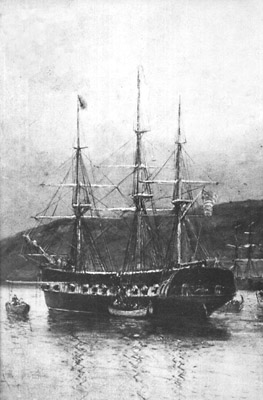
War broke out between the United States and Mexico in May 1846. This was partly because of land disputes over Texas. News of the war reached California about a month later.
The main U.S. forces in California were sailors and Marines from the Pacific Squadron. Some American settlers in California heard rumors of conflict. On June 15, 1846, about 30 settlers took over the small Mexican fort in Sonoma without a fight. They declared the "California Republic" and raised the "Bear Flag". This republic lasted only 26 days before joining the U.S. forces. Today's California state flag still has the bear and the words "California Republic."
On July 7, 1846, U.S. Navy ships captured Monterey, California, the capital of Alta California, without a fight. They raised the U.S. flag. Other coastal towns like San Francisco, San Jose, San Diego, and Santa Barbara were also taken over easily.
Taking Los Angeles
On August 13, 1846, U.S. forces entered Los Angeles. They left a small group of soldiers to control the city. But in September, Californios led by José María Flores and others fought back. The U.S. troops had to leave Los Angeles for a few months.
Over the next four months, there were small battles near Los Angeles and San Diego. In January 1847, a larger U.S. force re-occupied Los Angeles. The fighting in California ended when the Californios signed the Treaty of Cahuenga on January 13, 1847.
After this, the U.S. Navy captured all the cities and harbors in Baja California. However, Baja California was later returned to Mexico. California officially became part of the U.S. with the Treaty of Guadalupe Hidalgo in 1848.
California Becomes a State (1850)
From 1847 to 1850, California was ruled by U.S. military governors. This was a difficult time because many soldiers left to search for gold.
In 1849, because of the rapidly growing population, a Constitutional Convention was held in Monterey. Delegates wrote the first California Constitution. It was similar to the U.S. Constitution but had some key differences. It outlawed slavery and gave women the right to own their own property.
The new constitution was approved by voters in November 1849. San Jose was chosen as the first state capital. California officially became the 31st U.S. state on September 9, 1850, as part of the Compromise of 1850.
The state capital moved several times before settling in Sacramento, California in 1854.
The California Gold Rush (1848–1855)
The discovery of gold in 1848 caused a massive rush of people to California. The first to arrive were from nearby places like Oregon, Hawaii, Mexico, and Chile. By the end of 1848, about 6,000 people had come.
In 1849 alone, about 80,000 people arrived. Most were young men. They traveled by land on the California Trail or by sea around Cape Horn.
San Francisco became the main port for ships bringing goods and people. The city's population exploded from about 200 in 1846 to 36,000 in 1852. Many ships were abandoned in San Francisco Bay as their crews left for the goldfields. These ships were often used as stores or homes. San Francisco also suffered many big fires because of its wooden buildings and tents.
Before the Gold Rush, California had very little infrastructure. There were few towns, missions, and large ranchos. The sudden rush of people overwhelmed everything. Miners lived in tents and shacks. Wherever gold was found, new mining camps quickly appeared.
Travel to California was long and hard. Sailing ships from the East Coast took 5 to 8 months. Faster clipper ships could do it in about 120 days. Many people also took steamboats to Panama or Nicaragua, crossed the land, and then took another steamboat to California. This trip could be done in 40-60 days.
Impact of the Gold Rush
The Gold Rush had a huge impact.
- Transportation: Steamboats started running on the Sacramento and San Joaquin Rivers, carrying miners and supplies. Roads, bridges, and ferries were built.
- Agriculture: Farming grew to feed the new settlers. Wheat became an important crop.
- Mining Methods: At first, miners used simple methods like panning. Later, more complex methods like hydraulic mining and dredging were used. These methods caused environmental harm.
- Wealth: Millions of ounces of gold were found, greatly increasing the amount of money in the United States.
- Growth: The population boom led to the building of many new towns, businesses, churches, and schools.
Impact on Native Americans
The Gold Rush was very hard on California's Native American population. They were forced off their lands by miners and settlers. Many died from new diseases. There were also several massacres where hundreds of Native Americans were killed.
The state of California even paid "militias" to protect settlers, and these groups were involved in some massacres. The first governor, Peter Hardeman Burnett, openly called for the extermination of Native American tribes. This period was a great tragedy for the native people.
Later, Native Americans were moved to small reservations and rancherias. These places often lacked resources, making it hard for them to live as they used to.
Slavery in California
Some Native American tribes in northwest California practiced slavery before Europeans arrived. However, there were never black slaves owned by Europeans in California. Many free African Americans joined the Gold Rush.
The California Constitution of 1849 outlawed slavery. This helped California join the Union as a free state in 1850. But, under a law from 1853, some Native Americans were formally enslaved until the mid-1860s.
California in the Civil War (1861–1865)
California played a small but important role in the American Civil War. The state sent gold to the East to help the Union. Many Californians volunteered as Union soldiers.
Most California soldiers stayed in the West to guard forts and fight Native Americans. Some, like the California Column, marched east to fight Confederates in Arizona and New Mexico.
California was settled by people from both the Midwest and the South. While some favored the Confederacy, the state did not have slavery. The Republican Party, which supported Lincoln, took control of the state. A major success was getting approval to build the Central Pacific Railroad, the western part of the first transcontinental railroad.
Transportation in Early California
Early Trade Routes
Before Mexico took over, Spanish rules made it hard to trade with other countries. But Californios wanted new goods. So, they traded cattle hides and tallow for things like glass, tools, and luxury items. Ships from Boston sailed around Cape Horn to trade. This trip took about 200 days.
After 1848, shipping boomed. Cargo to California mostly came by sailing ship until the first Transcontinental Railroad was finished in 1869. Many ships arriving in San Francisco Bay were abandoned.
Overland Routes
The Butterfield Overland Mail Stage Line ran from 1857 to 1861. It carried passengers and mail over 2,800 miles from Missouri to San Francisco. The trip took about 28 days, traveling day and night.
During the Civil War, this route changed. A new route went through Utah and Nevada. The Pony Express also used parts of this route in 1860-1861, delivering mail quickly by horse. Telegraph lines were also built along these routes, connecting California to the East.
Once cargo left the ocean or rivers, it was usually moved by horse or ox-drawn wagons. Lumber and food were greatly needed. California soon started growing its own wheat, which was even exported.
Railroads Connect California
California's first railroad was built from Sacramento to Folsom in 1855. The first Transcontinental Railroad, connecting Sacramento to Nebraska, was completed on May 9, 1869. This linked California's major cities to the East Coast.
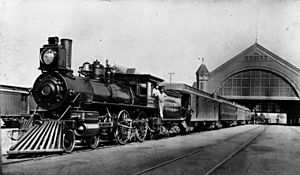
Southern California's first railroad opened in 1869, connecting San Pedro to Los Angeles. By 1876, Los Angeles was linked to Northern California by rail.

Over time, several major railroads connected California to other states. These railroads moved many goods and people, helping California's economy and population grow quickly in the late 1800s and early 1900s.
Electric railroads also started in the late 1800s, serving cities like San Diego and Los Angeles. Los Angeles's Pacific Electric system became the largest electric railroad in the world by the 1920s.

After World War II, passenger rail service declined because of new highways and airlines. But in the 1970s, new rail systems like BART were built. Today, commuter railroads and light rail networks serve many urban areas. In 2008, voters approved plans for a high-speed rail network.
Images for kids
-
National Historic Landmark commemorating and honoring Sir Francis Drake, Sebastian Rodriguez Cermeño, and Coast Miwok people at Point Reyes, California
-
The Russians from Alaska established their largest settlement in California, Fort Ross, in 1812
-
Map of the states and territories of the United States when California became a state in 1850. California was part of the Mexican Cession, and those parts outside of the state were organized into the Utah Territory and New Mexico Territory.
-
Concord stagecoach No. 251 in Wells Fargo livery
See also
 In Spanish: Historia de California para niños
In Spanish: Historia de California para niños


